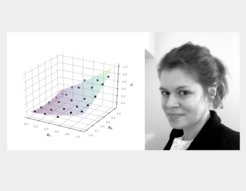Article by Frederike Zufall and her co-authors published in Artificial Intelligence and Law

To what extent can legal concepts and legal decision-making be transferred into mathematical models? Frederike Zufall and her co-authors Rampei Kimura and Linyu Peng have pursued this question for the legal concept of balancing interests. They developed two mathematical models to represent the decision of weighing two conflicting rights against each other.
The models show how the conflict between the right to the protection of personal data in Art. 7 and Art. 8 of the EU Charter of Fundamental Rights (EUCh) against the right of access to information derived from Art. 11 EUCh can be modelled in dependence to legal criteria such as the social status of the affected person, and the sphere from which the information originated, which are represented as inputs of the models. Building on the European Court of Justice’s ruling on the right to be forgotten, time is also defined as a legal parameter - which enables the model to show how the outcome of the balancing changes over the passage of time.
By comparison to other approaches based on machine learning, especially neural networks, the approach requires significantly less data. This might come at the price of higher abstraction and simplification, but also provides for higher transparency and explainability.
